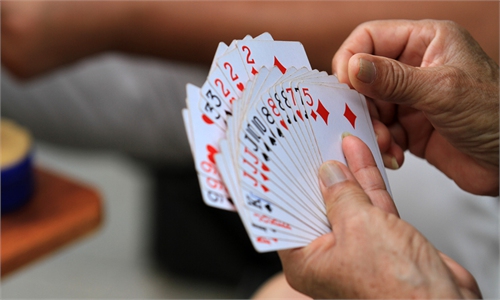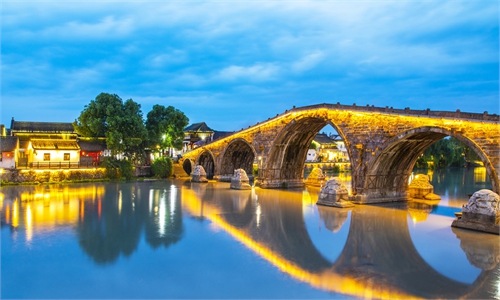ARTS / CULTURE & LEISURE
Chinese games inspire overseas players to embark on 'pilgrimages'
Trend setters

Scenery in Huanglong, Jiuzhaigou, Southwest China's Sichuan Province Photo: VCG
In recent years, with the rapid development of China's gaming industry, domestically produced games that incorporate Chinese cultural elements have gained immense popularity among international gamers. These elements give these games a unique appeal in the global market.
A game "pilgrimage" often refers to game enthusiasts visiting the real-world locations that inspired their favorite works, with these sites being referred to as "holy lands." Today, as many Chinese games gain popularity overseas, they are also driving a trend of pilgrimages among international gamers.
A month ago, pilgrimage videos of a Chinese game Genshin Impact went viral on major video sharing platforms, receiving numerous positive reviews and promoting various Chinese scenic spots. In one such video, German blogger Mikado first showcased some gameplay footage before transitioning to a shot of himself in a real-life location in China that resembles the game's scenes. This video has received over 700,000 views.
"As a player and fan of the Chinese game Genshin Impact, I often saw travel recommendations for this game on various video platforms. To learn more about the culture and stories behind the game, I registered an account on BiliBili (the Chinese equivalent of YouTube). My friends and I discovered potential real-world locations in China that served as the game's inspiration," Mikado told Global Times.
"Through these video platforms, I planned a detailed route for a game pilgrimage in China and posted videos along the way. During my travels, I found many real-life locations corresponding to the game's scenes," Mikado noted.
This type of content creation often satisfies players' curiosity and desire to explore game culture, allowing them to experience real-world versions of game scenes visually. Video creators vividly showcase the allure and historical background of these game pilgrimage sites through careful editing and commentary.

German blogger Mikado poses for a photo in Yangshuo, South China's Guangxi Zhuang Autonomous Region. Photo: Courtesy of Mikado
Cultural resonanceMikado mentioned that his interest in Chinese culture began when he was 12, recalling his first Chinese martial arts game, Age of Wushu. His fascination with Chinese games led him to major in Chinese language and history alongside East Asian art history at university.
"When I first started playing Genshin Impact, I noticed the game's landscapes were strikingly similar to real-world sites, such as the Huaguang Stone Forest in the game to Zhangjiajie, the Luhua Pool to Huanglong, and the Verdant Canyon to Yangshuo. After researching on YouTube, BiliBili, and Genshin forums, I learned that several locations in the game are based on real places in China," Mikado said.
"This information sparked my desire to visit China, not only to see these incredible landscapes in person but also to gain inspiration for my Chinese art studies, particularly in flower, mountain, and bamboo styles."
Mikado noted that Huanglong and Guilin most closely resemble the environments in Genshin Impact. Parts of Zhangjiajie and Jiuzhaigou also share similarities. Visiting these places was one of his most memorable experiences.
"I was particularly impressed with the well-organized national parks and environmental awareness in China, balancing nature conservation with visitor access. Europe doesn't have landscapes like Zhangjiajie, Huanglong or Yangshuo. Although we have stunning scenery like the Swiss Alps in Europe, the diversity and uniqueness of Chinese landscapes is unparalleled," Mikado noted.
Activities like bamboo rafting, which also appear in Genshin Impact, further enriched his experience and understanding of the region. However, the trip was more about cultural exchange and experiences.
"Sichuan opera and exquisite cuisines, including hotpot and sweet water noodles, offer flavors I could never find in Europe. Geographically, the limestone karst landscapes around Guilin and Yangshuo create some of the most breathtaking scenery I've ever seen. These unique formations have significantly influenced the local culture and the way of life."
According to the "2023 China Game Overseas Development Report" released at China Game Industry Annual Conference, Chinese game companies have normalized their overseas operations in surrounding regions, with their presence in North American and European markets gradually increasing.
Wider dissemination
Many gaming forums and video platforms feature numerous recommendations for real-world locations that correspond to game scenes. This content provides players with more in-depth and meaningful information for planning their game pilgrimage trips.
The dissemination of Chinese games overseas isn't limited to video platforms. In major cities, popular areas, public transportation, and large sports events worldwide, Chinese game companies frequently place billboards. For example, Chinese games like Genshin Impact, Rise of Kingdoms, and AFK Arena have placed ads in New York's Times Square, capturing the attention of many global players.
"I was pleasantly surprised and felt a sense of familiarity when I saw ads for Chinese games that I often play in Japanese subway stations and anime conventions," Wang Haoran, a Chinese student studying in Japan, told Global Times. "Recently, I've noticed a significant increase in Japanese friends playing Chinese games.
"The Chinese game Onmyoji, which is based on ancient Chinese mythology and folklore, was also very popular in Japan at one time. Two of my classmates even visited China to pilgrimage the locations depicted in the game, to learn more about traditional Chinese culture and myths," Wang said.
Likewise, Mikado's pilgrimage trip is far from over. "I plan to visit Chengdu to see the pandas and celebrate the Lantern Festival in Zigong. My travel itinerary includes taking a train from Guangzhou to Guilin, then a boat to Yangshuo. I've researched various options, such as hiring a driver for transportation. I also plan to visit historical cities like Xi'an, Chongqing, and Luoyang."



